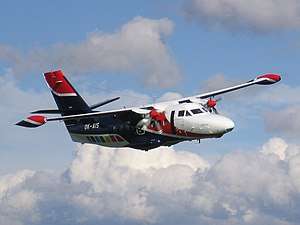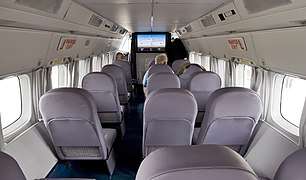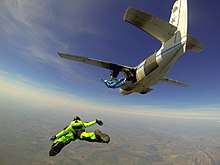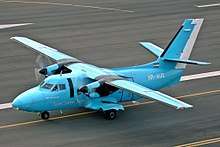Let L-410 Turbolet
The Let L-410 Turbolet is a twin-engine short-range transport aircraft, manufactured by the Czech aircraft manufacturer Let Kunovice (named Aircraft Industries since 2005), often used as an airliner. The aircraft is capable of landing on short and unpaved runways and operating under extreme conditions from +50 °C (122 °F) to −50 °C (−58 °F). BY 2016, 1,200 L-410s had been built, and over 350 are in service in more than 50 countries.[1]
| L-410 Turbolet | |
|---|---|
 | |
| Role | Regional airliner, cargo aircraft |
| Manufacturer | Let Kunovice |
| First flight | 16 April 1969 |
| Introduction | 1970 |
| Status | In service |
| Produced | 1971–present |
| Number built | 1,200[1] |
| Unit cost |
L-410 UVP-E20: $6.3 Million (2016)[2] |
| Variants | Aircraft Industries L 410 NG |
Development
.jpg)

Development of the L-410 was started in the 1960s by the Czechoslovak aircraft manufacturer Let Kunovice. The Soviet airline Aeroflot was looking for a turboprop-powered replacement for the Antonov An-2 aircraft, initiating the design development by Let. After preliminary studies of an aircraft called the L-400, a new version was introduced called the L-410 Turbolet. The first prototype, designated XL-410, flew on April 16, 1969. Because of delays in the development of a suitable Czech engine (Walter M601), the prototype and first production version were powered by Pratt & Whitney Canada PT6-27 engines.
After M601 development was completed, the PT6 engine was replaced by M601 engines coupled with Avia V508 three-blade propellers and the next variant was introduced, the L-410M.
A further version for Aeroflot was the L-410 UVP. This has improved performance in take-off and landing due to increased wing and tail area - STOL. However, due to an increased empty weight and a shift in the center of gravity, the aircraft had a decreased seating capacity: 15 passengers.
The L-410 UVP-E (the most common variant of the L-410) has increased maximum take-off weight to 6400 kg, M601E engines with increased power, new five-blade propellers designated V 510 and the provision for wing tip tanks to increase fuel quantity. First flight was made in 1984, and production started in 1986.
The L-410 UVP-E9 and UVP-E20 are versions which vary from each other only by minor changes arising from various certification regulations. The last L-410 family member is the L-420 which uses the new Walter engine variant, the M601F. Currently produced L-410 UVP-E20s are powered by next derivative of M601 engine designated as GE H80-200 and new Avia Propeller AV-725 five blade propellers.
The L-420 was first approved by the US FAA on March 11, 1998, then the L-410 UVP-E20 on June 30, 2015.[3] The L-410 UVP-E20 was EASA certified on 4 February 2005 on the other variants on 28 March 2007.[4]
On 3 September 2013 the Russian company UGMK (Iskander Machmudov) became the wholesale owner of LET Kunovice Aircraft Industries. They announced that they would produce the L-410 also in Russia within the year.[5] On 7 July 2015 UGMK represented first L 410 NG aircraft manufactured in Russia.[6]
Design
.jpg)
The L-410 UVP-E is an unpressurized all-metal high-wing commuter aircraft, with Avia V 510 five-blade propellers. It is equipped with a retractable undercarriage. The aircraft uses two hydraulic circuits: main and emergency. The main electrical system operates with 28V DC. The de-icing system is leading edge pneumatic deicers and electrical heating of propellers, cockpit windshields and pitot-static system heads. Maximum take-off weight of the L-410 UVP-E is 6400 kg with the possibility of an increase to 6600 kg for the E9 and E20 variants, seating capacity 17 to 19. Cruise speed is 170 KIAS, maximum range about 770 nautical miles (1,430 km). The airplane is certified for IFR operation, CAT I ILS approach, and flights in icing conditions.
The L 410 UVP-E20 is certified on the basis of FAR 23 either Amendment 34 or Amendment 41. It is certified by the EU, the Russian Federation, the US, Brazil, Argentina, Chile, Peru, Venezuela, Cuba, India, Nepal, Philippines, Korea, Indonesia, Republic of South Africa, Algeria, Australia, Taiwan, Turkey, and many other countries accepting some of the previous certificates.[7] The aircraft has also been approved for operation in a number of other countries, such as Kenya, Tanzania, Uganda, Tunisia, Colombia, Venezuela, South Korea and others.
Variants
_RP25461.jpg)
- L-410: Prototype, three units built.
- L-410A: First series with Pratt & Whitney PT6A-27 turbo-prop engines. Twelve built.
- L-410AB: Version with four-bladed propellers.
- L-410AF: Aerial photo version supplied to Hungary.
- L-410AG: With modified equipment. Never built.
- L-410AS: Test aircraft, supplied to the USSR. Five airplanes built
- L-410FG: Aerial photography version based on L-410UVP
- L-410M: Second series with Walter M601A engines.
- L-410AM: Version with improved M601Bs, also known as L-410MA or L-410MU.
- L-410 UVP: (Ukorochennaya vzlot-posadka, "short take-off and landing") Third series, fundamentally modified. Main changes are a trunk, an extended wingspan by 0.80 m (2.6 ft), M601Bs, a higher horizontal stabilizer. The UVP variants possesses STOL characteristics.
- L-410 UVP-S: Salon variant of the UVP with upward hinged entrance hatch.
- L-410 UVP-E: Re-equipped with M601Es, five-bladed Avia V510 propellers, additional fuel tanks at the wing ends.
- L-410T: Transport variant of the UVP with larger loading hatch (1.25 m × 1.46 m (4.1 ft × 4.8 ft)), can transport 6 stretchers as a medical airplane with a medic, or 12 parachutists. It can also carry 1,000 kg of cargo containers.
- L-420: upgraded L-410 UVP-E - new M601Fs, certified variant of the L-410 UVP-E20
- L 410 NG: New version featuring a longer nose and a larger rear area to contain twice as much luggage, new more powerful and quieter GE H85 engines with propellers Avia-725, new wing design and a new modern cockpit. It has a double range and more endurance compared to the original types. It made its first flight on 29 July 2015.[8] Power grew up to 850 shp instead of the previous 800 shp GE H80-200, speed increased to 223kt (412 km/h). Maximum take-off weight rose 500 kg to 7,000 kg and range to 1,350 nm up from the original 820 nm (1,520 km). Fuel capacity rose from 1,300 kg to 2,450 kg and endurance from 5h to 9h. FAA, EASA and Russian certification took place in late 2017.[9] Serial production began in March 2018.
Operators

Many L-410s were delivered to the former Soviet Union and ex-Soviet states and stayed there and in Russia, but some have been also sold to airlines in Asia, Africa, Central America, and South America. Forty aircraft are in use throughout Europe for commercial operation or skydiving.
Civilian
In July 2015, 178 Let L-410 were in airline service : 73 in Africa, 58 in Europe, 41 in Americas and 6 in Asia Pacific and the Middle East ; its airline operators with four or more aircraft were:[10]
- 25: Air-Tec Global
- 8: Orenburzhie Air Company
- 7: Searca
- 5: Kin Avia and Petropavlovsk-Kamchatsky Air Enterprise
- 4: Air Express Algeria, Eagle Air, Solenta Aviation, 2nd Arkhangelsk United Aviation Division, Van Air Europe, Komiaviatrans, KrasAvia, Air Guyane Express and Comeravia
Notable accidents
The L 410 has experienced 116 accidents with 426 fatalities.[11] With at least 20 fatal crashes from 2003 to 2013, it is one of the most accident-prone aircraft.[12] However, the operator's safety rating and operations procedures are more important than the aircraft design, and the L-410 operate where most aircraft cannot, in rugged mountains and jungles, often onto grass or gravel runways; the latest L-410 UVP-E20 and L-420 produced since 1990 have an excellent safety record.[13]
Specifications (L-410 UVP-E20)
_(9718636097).jpg)
Data from LET[1]
General characteristics
- Capacity: 19 passengers / 1,800 kg (3,968 lb) payload
- Length: 14.42 m (47 ft 4 in)
- Wingspan: 19.98 m (65 ft 7 in)
- Height: 5.97 m (19 ft 7 in)
- Wing area: 34.86 m2 (375.2 sq ft)
- Aspect ratio: 11.45
- Airfoil: root: NACA 63A418; tip: NACA 63A412[14]
- Empty weight: 4,200 kg (9,259 lb)
- Max takeoff weight: 6,600 kg (14,551 lb)
- Fuel capacity: 1,300 kg (2,866 lb)
- Powerplant: 2 × General Electric H80-200 turboprop engines, 597 kW (801 hp) each
- Propellers: 5-bladed Avia AV 725, 2.3 m (7 ft 7 in) diameter
Performance
- Cruise speed: 405 km/h (252 mph, 219 kn) max cruise
- Range: 510 km (320 mi, 280 nmi) 1,800 kg (3,968 lb) payload, ISA, FL140, 45 min reserve
- Endurance: 5 hours 6 minutes
- Service ceiling: 8,382 m (27,500 ft)
- Rate of climb: 8.5 m/s (1,670 ft/min)
- Fuel consumption: 240 kg/h (529 lb/h)
- Take-off run: 510 m (1,673 ft) (ISA, SL, MTOW)
- Landing run: 500 m (1,640 ft) (ISA, SL, MTOW)
See also

Related development
Aircraft of comparable role, configuration and era
- Antonov An-28/PZL M28 Skytruck
- Beriev Be-30
- Britten-Norman Trislander
- CASA C-212 Aviocar
- de Havilland Canada DHC-6 Twin Otter
- Dornier Do 228
- Embraer EMB 110 Bandeirante
- Harbin Y-12
- IAI Arava
- Short SC.7 Skyvan
References
- L 410 UVP-E20 brochure (PDF), LET, 2016, archived from the original (PDF) on 2019-04-23
- "Aircraft Industries, a.s. made a great step towards opening up the Chinese market" (PDF) (Press release). LET Aircraft Industries, a.s. 1 Apr 2016.
- Type Certificate data sheet No. A42CE (PDF), FAA, June 24, 2016
- Type Certificate data sheet A.026 Issue 22 (PDF), EASA, August 14, 2017, archived from the original (PDF) on August 18, 2017
- "Новости NEWSru.com :: Чешский самолет L 410 окончательно станет российским". newsru.com. 2013-07-25. Retrieved 7 March 2016.
- "ВЗГЛЯД / УГМК представила новый российский самолет L-410 NG". vz.ru. Retrieved 7 March 2016.
- "Certificates L-410". LET. Archived from the original on 2017-08-18. Retrieved 2017-08-17.
- "Let L-410NG". Airliner World: 19. October 2015.
- "ILA: Aircraft Industries targets 2016 sales for new L 410 turboprop". Flight International. 31 May 2016.
- "World Airliner Census" (PDF). Flight Global. August 2015.
- Ranter, Harro. "Aviation Safety Network > ASN Aviation Safety Database > Aircraft type index > Let L 410 > Let L-410 Statistics". aviation-safety.net.
- Oliver Smith (19 June 2013). "'Least safe' aircraft models revealed". The Telegraph.
- Christine Forbes Smith (June 26, 2013). "Design of aircraft is rarely a crash factor".
- Lednicer, David. "The Incomplete Guide to Airfoil Usage". m-selig.ae.illinois.edu. Retrieved 16 April 2019.
External links
| Wikimedia Commons has media related to Let L-410. |
- Official website
- Fred George (Jun 17, 2013). "Pilot Report: L410 UVP Turbolet". Aviation Week Network.